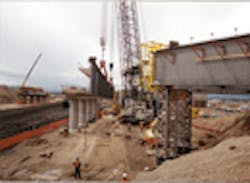State governments are trying new tactics to generate funds needed to operate, repair, and expand their roadway networks – efforts exacerbated by recent cutbacks in federal highway monies.
Pennsylvania’s state legislature, for example, is wrestling plans to generate $1 billion in extra monies through increased taxes and fees to help it reach a $3.5 billion a year funding level required to keep highways, bridges and transit in a state of good repair, according to research compiled by Pennsylvania’s Dept. of Transportation (PennDOT).
Despite additional investments in recent years, PennDOT said the state has 5,646 structurally deficient bridges – leading the nation in the number of such spans and exceeding the total number of similarly deficient bridges from Virginia to Maine, combined. Pennsylvania also has more than 10,000 mi. of state roads in need of repair, with 7,000 mi. of those classified as in “poor” condition, the agency added.
“Every month we delay, the cost of repairs goes up,” noted Pennsylvania Gov. Edward Rendell (D) recently. “The time for legislative action is now; otherwise future generations will pay a much higher cost.”
He noted that keeping up with spiraling roadway costs is one reason more money is needed. For a roadway project that cost only $300,000 in 1987, it would now cost more than $720,000 to complete today.
Rendell is seeking an 8% tax on the gross profits of oil companies doing business in Pennsylvania along with increasing a variety of license, registration and vehicle fees to generate the $1 billion in additional roadway funding. He estimated the oil company tax would generate $576 million in its first full fiscal year, noting that oil firms paying the tax would be exempt from the state’s 9.99% corporate net income tax and would also be legally barred from passing the increase on to consumers.
In Arizona, state DOT officials want to open up rest stops to commercial businesses in order to help underwrite operating expenses. Arizona DOT Director John Halikowski noted that it costs the state more than $300,000 a year on average to operate a single rest area, including repairs to aging water, sewer, and electrical systems.
Last year, Arizona closed 13 rest areas due to budget cuts and the need to fund emergency snow removal operations following harsh winter storms. That’s why Halikowski said he is among a growing number of state officials seeking to amend a 1956 federal law banning the commercialization of public highway rest stops; largely because the law does not give states the flexibility needed to adequately fund rest area costs.
The funding issue is also now being exacerbated by cutbacks in federal monies. The Federal Highway Administration (FHWA) is rescinding $2.2 billion to help cover the cost of a new law passed by Congress and signed by President Obama Aug. 13 that extends $16 billion in Medicaid funding to states by six months and offers a further $10 billion to help cover teacher salaries for the upcoming school year.
The $2.2 billion cutback is being apportioned based on the amount of money states send to the federal government in terms of fuel and other highway taxes. For example, Delaware, the District of Columbia, and Vermont must reduce their highway budgets by $8.5 million, while California must slice out $205 million.
About the Author
Sean Kilcarr
Editor in Chief
Sean Kilcarr is a former longtime FleetOwner senior editor who wrote for the publication from 2000 to 2018. He served as editor-in-chief from 2017 to 2018.
